|
Index...
|
 was born in 1938 and grew up in my parents' third home newly built on the former Triumph sports ground, in Wyver Crescent, just where the Crescent bends towards Bromleigh Drive. At the rear the entry led into a cul-de-sac, Ambler Grove. This is where I learned to ride a two-wheel bicycle, my Dad holding the saddle and running after me as I sped down the sloping road. Fortunately, I had been shown how to operate the brakes. This would be about 1946, soon after the war had ended.
was born in 1938 and grew up in my parents' third home newly built on the former Triumph sports ground, in Wyver Crescent, just where the Crescent bends towards Bromleigh Drive. At the rear the entry led into a cul-de-sac, Ambler Grove. This is where I learned to ride a two-wheel bicycle, my Dad holding the saddle and running after me as I sped down the sloping road. Fortunately, I had been shown how to operate the brakes. This would be about 1946, soon after the war had ended.
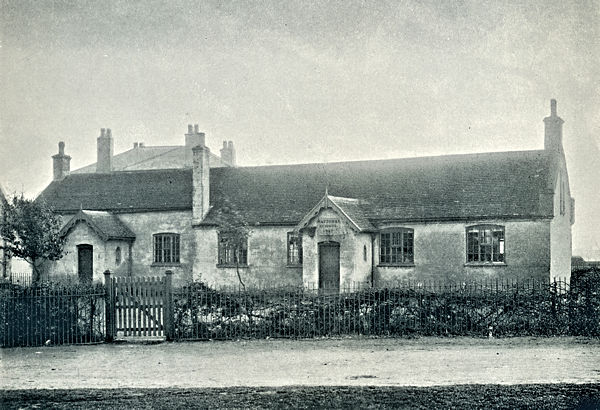 Stoke National School as it looked in 1897.
Stoke National School as it looked in 1897.
My Dad worked at Rootes, Ryton, and soon he bought an old Lanchester car with double de-clutch gear operation. This would be when petrol first came off the ration, perhaps in 1947. We had occasional family outings to relatives in Lincolnshire. On one well-remembered occasion, when we reached the Leicester ring road the 'big-end' went and we had to abandon the car and return to Coventry by bus. I don't recall how it was brought back or if that was the end of it, but I think so.
The people next door had two children, a boy a year younger than me and his sister, perhaps two years younger. He went to Binley School and later to Bablake. I, however, was sent to the National School on Stoke Green (pictured left), where my Dad and his twin sister Ivy had also started school as they lived nearby in Hugh Road. I went to school by bus number 9 from the Copsewood terminus just inside Momus Boulevard, where Bromleigh Drive joins. In 1943 the bus had rexine concertina blinds to let down at night with a small gap on the near side, so passengers could see where to alight. The tickets were taken from a board with spring clips to hold the tickets of differing value and colour, which were punched by the conductor. No bus at that time could set off without a crew of two, driver and conductor. Some of the conductors were female but all the drivers were male.
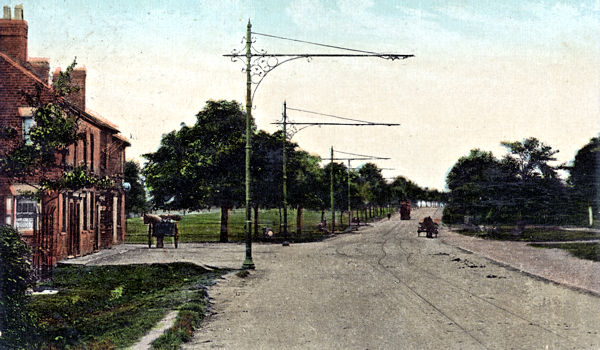 Bull's Head pub, Binley Road, c1907.
Bull's Head pub, Binley Road, c1907.
It was a halfpenny ride to the Bull's Head for my journey to school, and then the short walk to the corner of Stoke Green, passing en route, from the corner of Bull's Head Lane, Bert Kendall, butcher (my mother's cousin); Ison's, the local undertaker; Rogers, the man's barber (where I first had my hair cut); Pattison's Dancing Academy (where the reception for my parents' wedding at Stoke Church was held in 1931); three old cottages and then the school gate.
One of my first memories was of the alphabet in the reception class on small boards with an appropriate picture (e.g. apple, bat, cat, etc.). Miss Grindrod was the teacher, bespectacled and tall. On Fridays there was a 'Free lesson' when you would be handed a wooden jigsaw or perhaps paper and crayons to draw a picture. I think talking (quietly) was then permitted.
I also recall the announcement in the next class of the death of the American President, Franklin D. Roosevelt, in April 1945. I had no idea who he was or the significance of this announcement until much later. The hedge in the playground had a branch at the corner, where the two roads met - it was just the right height for small children to sit on! I sat there many times and wondered if my dad and aunt had sat there too. From Miss Grindrod's class I moved up into Miss Smith's class, only she married and became Mrs. Moon.
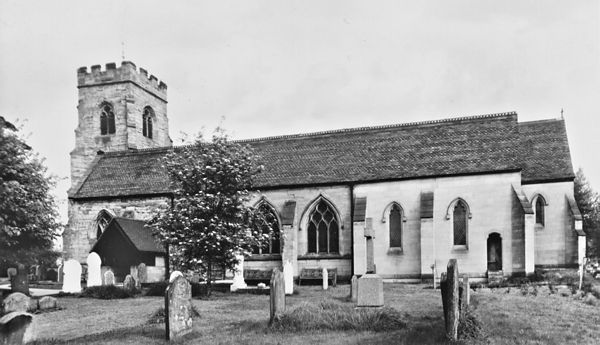 Stoke St. Michael's Church, 1959.
Stoke St. Michael's Church, 1959.
The next class was Miss. Portlock's (she had taught my father and aunt). Grey hair in a bun with glasses, and heavier looking than the other teachers, to us she seemed so old, but was probably only forty. When the teacher, or sometimes a visitor, came into the classroom, the whole class would have to stand up quietly. We might then be told to sit and Miss Portlock had something else for us she called 'Thumbs in prison', which meant linking your thumbs behind your back and keeping them there until told to release them. You had to stand and greet the teacher and/or visitor with "Good Morning, Miss/Mr/Rector" etc., when they entered the classroom. Talking was not allowed. Discipline was strict. Boys could only stay at the school until the age of eight. Then they were transferred whilst the girls remained another year. (I moved with another boy I knew to Folly Lane School in Humber Road, it became Gosford Park school whilst we were there.)
A Church of England school, as well as times tables, we were taught the Commandments, which we learned to say together by rote and, when the Rector visited, we had to stand up and recite them. We also sang, I suppose mostly folksongs and a hymn called Jubilate.
On Ascension Day the whole school walked in a crocodile to Stoke St. Michael's Church for the Service, after which we were given a half day's holiday! Miss Steele was the headmistress (she must have been Scottish but I did not realise then), and her office was in a weather-boarded hut behind Miss Portlock's classroom.
 ack to the Triumph estate. The local shops were in Bromleigh Drive. The post office which sold cards and stationery; the Dainty Stores a grocery shop; Steve Cusworth, butcher (his father, also a butcher at Hurrells in the City Arcade, with his wife, lived next to my maternal grandparents in Coundon); the greengrocer, also sold fish and penny ice cubes with a smidgeon of orange juice (nearest one could get for a lollipop in wartime), and the Off Licence on the corner of Sapphire Gate. Here they accepted pop bottles returned for a few pennies (old money).
ack to the Triumph estate. The local shops were in Bromleigh Drive. The post office which sold cards and stationery; the Dainty Stores a grocery shop; Steve Cusworth, butcher (his father, also a butcher at Hurrells in the City Arcade, with his wife, lived next to my maternal grandparents in Coundon); the greengrocer, also sold fish and penny ice cubes with a smidgeon of orange juice (nearest one could get for a lollipop in wartime), and the Off Licence on the corner of Sapphire Gate. Here they accepted pop bottles returned for a few pennies (old money).
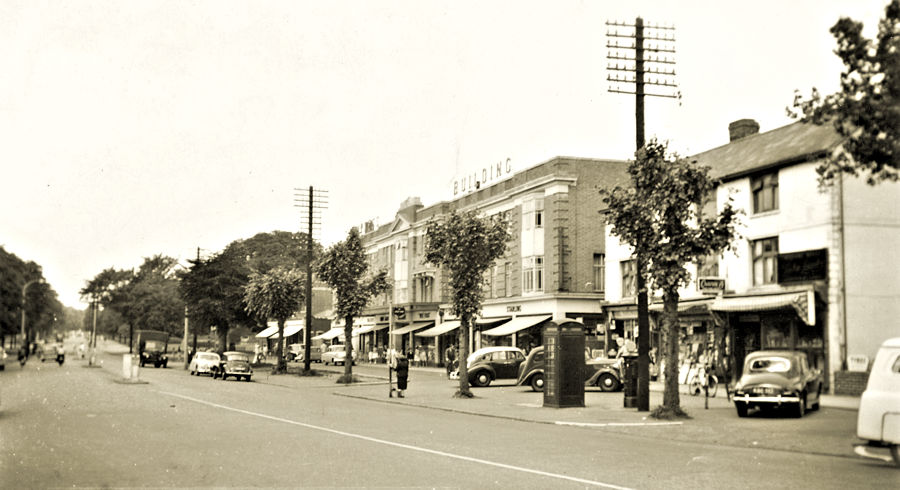 Empress Buildings, Binley Road, opposite the Bull's Head pub, 1967.
Empress Buildings, Binley Road, opposite the Bull's Head pub, 1967.
There were other shops in Stoke. On the Binley Road opposite the Bull's Head stood the Empress Buildings (above), named after Queen Victoria; a lending library; Reason's wool shop; an electrical shop; a post office; Duckham's hardware and a petrol pump; with, at the Bray's Lane end, a Co-operative grocery and butcher's shop.
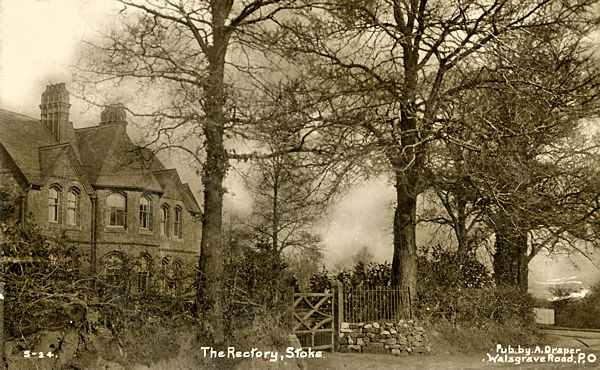 Stoke Rectory, corner of Church Lane and Binley Road, c1920.
Stoke Rectory, corner of Church Lane and Binley Road, c1920.
Farther down Church Lane, which began at the Stoke Rectory on Binley Road (pictured left), Burns Road led to Walsgrave Road with another parade of shops. Isherwood's pork butcher (lovely sausages); post office; men's outfitter; and a branch of Holbrooks on the corner with Church Lane. Farther up Walsgrave Road, towards town, Ball Hill had other shops, quite a number selling a variety of items.
On the corner of Bromleigh Drive and Momus Boulevard was a detached bungalow, which had a direct hit during the blitz on Coventry. The crater stayed there throughout the war because building materials were in short supply and could only be had with a permit. Living in Momus Boulevard until my marriage I saw the bungalow rebuilt, but it is a clear memory as the bus terminus was just next to it. We sometimes went along Brindle Avenue to the Sports ground, beyond which was a coppice with trees from which we would take hazel catkins and pussy willow from near a stream (this would not be possible today but was not an issue at that time), or as a family we would cycle to Coombe Ridings - I sat on a child seat on my Dad's crossbar. My mother and brother had their own bikes.
In the school holidays and at other times we played games; conkers (horse-chestnuts on a piece of string), hop scotch, tag, follow my leader, rat-tat-ginger - thus annoying the neighbours as it meant daring someone to knock at the door or ring the bell, then hide and escape with peals of laughter when no-one was found at the door. I remember a piece of rough ground near St. Andrew's hall (where there was a Sunday school), which had low branches and long grass where we might make a den to sit in. (It all sounds so unsophisticated these days, but at that time children had simple pleasures.) Or we might cross the road to Brindle Avenue, leading to the GEC sports ground, where on the left was a stable which housed a donkey, and vegetables were for sale. Getting more adventurous would be to run down Binley Hill to Binley Bridge beneath which flowed the river Sowe. Certain times of the year the water level was low and we could paddle, but once a tragedy occurred there when a boy who had leg irons went in after we left and was drowned.
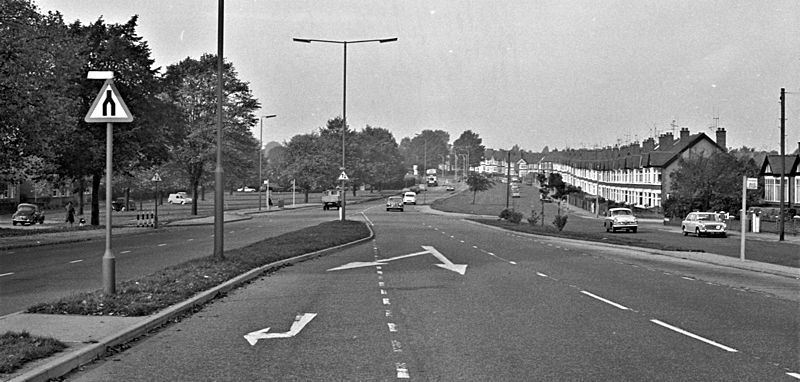 Binley Road near Brindle Avenue, looking towards the city centre in the late 1960s.
Binley Road near Brindle Avenue, looking towards the city centre in the late 1960s.When a person in Wyver Crescent, or any other street, died, the custom was, as my mother explained, for neighbours to close their curtains as a mark of sympathy, especially at the time of the funeral. I found this confusing, in the summer months, when people closed curtains to keep the sun off the furnishings. Our neighbour next door was a very lovely and helpful person. It was known that she had been a nurse at one of the London hospitals, and also that she had served as a missionary in India, prior to her marriage. She was the first port of call if anyone had a medical emergency or accident, always willing to give help and advice, with a measure of good sense.
I have mentioned that my mother's parents lived in Coundon, in fact in Malvern Road, at the top of the hill of Holyhead Road. For me it was exciting to go (especially in summer) as a family, with my elder brother and parents, on the number 9 bus to Gosford Green, then go past the fountain at the corner on to Walsgrave Road to catch the 11 Inner Circle bus that would take us to Grayswood Avenue. A walk up Holyhead Road and we were there. Of course, I would sometimes stay at my grandparents in the school holidays and other times, such as birthdays or Christmas, when a great-aunt and uncle might be visiting. On one occasion my grandmother had a fire in the dining room, airing bed clothes on a horse in front of the fire. A draught from the chimney caught the sheets and they began to burn. Thinking quickly, she opened the French doors and threw the burning items into the garden, but she was not quick enough to avoid some damage; the wooden over-mantel surround had to be replaced, and the old German black clock lost its eagle which surmounted the time-piece. So fortunate that she was there to see it happen. When I was ten, I dreamt about this clock in that same room where my grandfather in his final illness had a bed downstairs.
Website by Rob Orland © 2022 to 2026